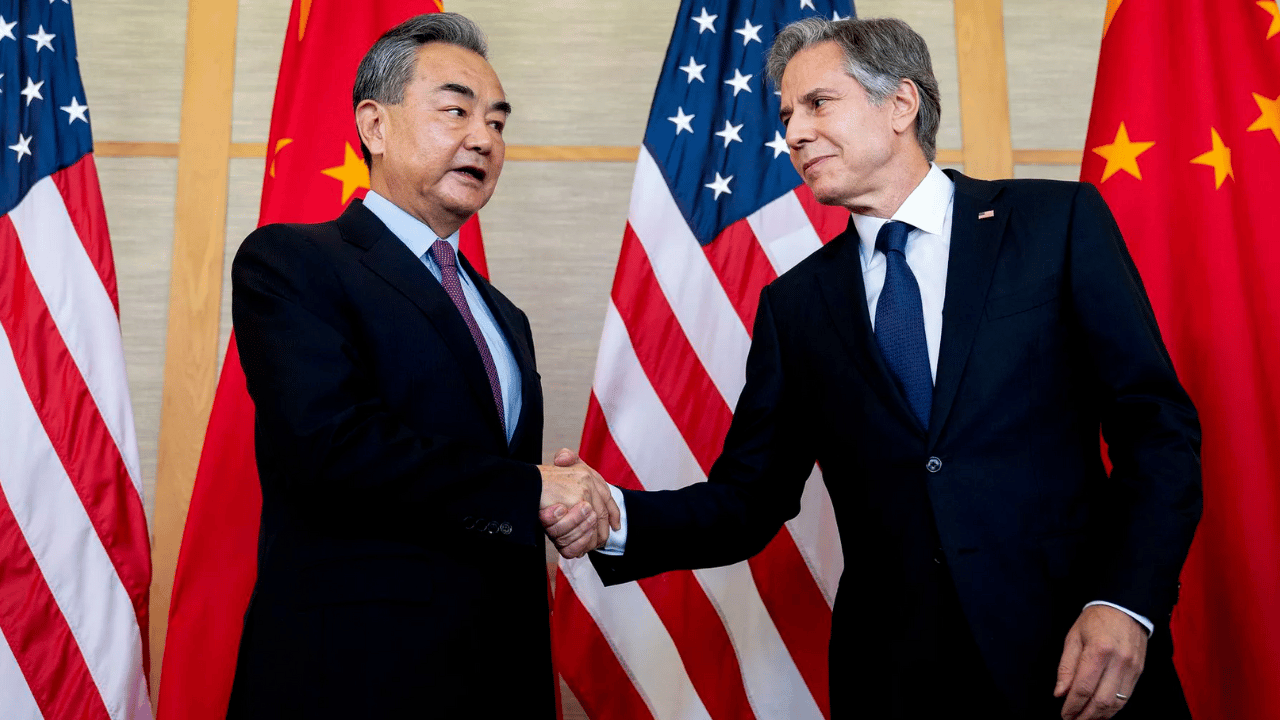Amid simmering tensions between Washington and Beijing, Secretary of State Antony Blinken met with his Chinese counterpart Wang Yi at the Munich Security Conference on Saturday. After the White House ordered the military to shoot down a Chinese balloon which floated over the continental United States, there was a major breakdown in diplomacy. Previously, US officials suggested Blinken would take advantage of the opportunity to help de-escalate the situation and reach some quasi-détente. Instead Blinken confronted Wang over the balloon incident and warned China against providing weapons to Russia for use in its war with Ukraine.
“This was an opportunity to speak very clearly and very directly about the fact that China sent a surveillance balloon over our territory, violating our sovereignty, violating international law. And I told him quite simply that that was unacceptable and can never happen again,” Blinken told NBC’s “Meet The Press.” Without providing further details on the meeting, Blinken said “I can tell you, no, there was no apology.”
After the Pentagon announced a Chinese balloon had entered U.S. airspace and that it posed no threat to Americans, Blinken canceled his long planned trip to China where he would have met with Wang and possibly President Xi Jinping.
Though the Department of Defense claims – without evidence – that it was a surveillance device, Beijing maintains that it was a meteorological balloon, for civilian purposes only, and that it entered US airspace as a result of abnormal weather. Last week, the Washington Post also reported that unexpected weather blew the balloon off course, adding US intelligence and military agencies had tracked the balloon since it was launched from Hainan Island, China’s southernmost province.
They expected the balloon to travel over to Guam, where the Marine Corps is opening new bases as part of Washington’s “Asia Pivot,” a policy launched during the Barack Obama administration to encircle China in preparation for a future war, the largest military buildup since World War II.
The balloon was shot down by a F-22 on February 4th, after which Pentagon Chief Lloyd Austin was declined a call with his Chinese counterpart. On Wednesday, Chinese Foreign Ministry spokesman Wang Wenbin declared Washington’s actions have “had a grave impact on the efforts and progress made by China and the US in stabilizing bilateral relations” since President Joe Biden met with XI in Bali last fall. Beijing also said that at least 10 US high-altitude balloons have flown over its territory since last year.
Wang also pointed to the heavy American military presence in waters surrounding China, saying “US military vessels and aircraft conduct frequent close-in reconnaissance on China, including 657 sorties last year and 64 sorties in January this year in the South China Sea alone, which seriously undermines China’s national security and regional peace and stability.”
Blinken says he emphasized Washington’s “deep concern” over information he claims the US has that shows China is considering providing “lethal assistance” to Moscow as well. “We’ve been watching this very, very closely. And, for the most part, China has been engaged in providing rhetorical, political, diplomatic support to Russia, but we have information that gives us concern that they are considering providing lethal support to Russia in the war against Ukraine.”
“We see China considering this. We have not seen them cross that line,” he asserted. “We are concerned that this is something that China was not doing for many months but may be considering now,” adding if China crosses that line it could spark a “new Cold War.”
Blinken said the US is only sharing this intelligence with allies right now and implied it reveals a sudden shift in China’s posture regarding the war in Ukraine. In response to a question about how “lethal” support is defined, Blinken clarified “everything from ammunition to the weapons themselves.”
“To date, we have seen Chinese companies and of course, in China, there’s really no distinction between private companies and the state. We have seen them provide non-lethal support to Russia for use in Ukraine. The concern that we have now is based on information we have that they’re considering providing lethal support,” he said.
Earlier this month, the Wall Street Journal reported that Russian customs records show “Chinese state-owned defense companies shipping navigation equipment, jamming technology and jet-fighter parts to sanctioned Russian government-owned defense companies.” The report also discussed other “dual-use” goods making their way to Russia from Chinese companies, both state-owned and private.
If Blinken’s unverified claims proved to be true, this would mark a significant shift in China’s foreign policy. As analyst Ted Snider has explained,
This increasingly close and comprehensive [China-Russia] partnership is not refuted by China’s restraint in helping Russia militarily in Ukraine. China has continued to support Russia diplomatically and economically. Expecting China to abandon restraint and come to Russia’s aid militarily is expecting too much. Neither China nor Russia believes in Cold War-style alliances. Though their extraordinarily close strategic partnership approaches a quasi-military alliance, it falls importantly short of a military alliance: there are no mutual defense obligations. The two countries will never oppose each other, but the partnership respects the right of the two countries to pursue their own interests. China would come to Russia’s aid only if China’s security interests were threatened. That could happen if China sees an existential threat to its strategic partner. But its restraint so far is consistent with the relationship.
At the same time, in addition to the new Marine bases in Guam, the US has been greatly increasing military pressure on China. In recent weeks and months, the US has sailed a guided missile destroyer through the sensitive Taiwan strait, committed billions of dollars in military aid to Taiwan, expanded US National Guard training programs with the Taiwanese military, worked on deals to gain exclusive military access to the Federated States of Micronesia. In addition the US Navy sailed an aircraft carrier strike group into the South China Sea to conduct war drills with the Marines, secured an agreement with Manilla to gain access to four more military bases in the Philippines and awarded contracts to begin work on a new radar installation in Palau, announced increased cooperation between American and Japanese armed forces for a future confrontation with China, and made plans to deploy additional Marine units armed with anti-ship missiles along the Okinawa islands.
The hawkish Senator Lindsey Graham (R-SC) demanded the world “come down hard on China” if Beijing provides Russia with weaponry. He said it would be the “most catastrophic thing that could happen to the U.S.-China relationship. … That would change everything forever.”
Linda Thomas-Greenfield, the US ambassador to the United Nations, also warned that if China arms Russia in its fight with Ukraine “that would be a red line.”
In less than a year, the US has funded Kiev with well over $100 billion in mostly military aid. Last week, top Russian diplomats issued dire warnings that both Washington and its NATO allies have crossed all of Moscow’s “red lines” and war with the US is close.
This article was originally featured at Antiwar.com and is republished with permission.
































